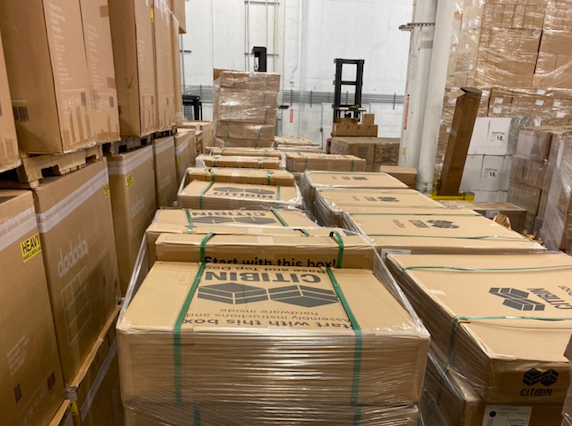Maybe I’m Not Ready to Sell to Costco

My COO would say that I have a bad history when it comes to purchasing inventory. And he would be right. In one of the reports he created upon joining the business last year, he showed 26 “months of supply” for a particular product for which I had had high hopes. I called it “planning for success.” My COO called it “overstock.”
By Liz Reisch Picarazzi
In my last column about whether I should try to sell my products in Costco, I explored what it might do to help or hurt my brand. I’ve looked at it from many angles and sought the advice of fellow entrepreneurs. But the what-would-you-do? question isn’t super useful unless you’re talking to someone who has been down the same road you’re considering.
Lucky for me, I have an editor who has covered businesses for 20 years and knows many entrepreneurs. In a discussion about whether or not to go Costco, Loren recommended that I get the perspective of Carey Smith, the founder of Big Ass Fans, who built a $260-million yearly revenue fan business without selling through mainstream retailers. A lot of entrepreneurs are impulsive, especially when we think we’ve found the person or thing that can help us get over the latest hurdle. So I emailed Carey immediately at his investment firm, Unorthodox Ventures, and got myself on his calendar.
I planned to talk about my idea to prototype a less-expensive version of our premium trash enclosure and see whether Carey thought the margins would be worth it. And I was eager to get his perspective on the very real possibility of my economy products cannibalizing my premium products.
We spoke briefly about those topics, but Carey quickly zeroed in on something else: my readiness. Retailers expect suppliers to demonstrate that they can produce and distribute at THEIR volumes. With my current 12-week lead time on delivery of most Citibin products, I wouldn’t be able to get a seat at the table with Costco or other major retailers.
It’s bad to run out of inventory in any sales channel, but particularly with national chains that expect smooth and fast fulfillment. Because we have strong relationships with customers, they have been mostly understanding of the delays, even when paying several thousand in full and needing to wait three months. Costco, however, essentially protects their customers from delays by choosing brands that can fulfill. I happen to be a Costco member, and I appreciate that.
About those delays: obviously, the pandemic has ushered in a “new normal” of global logistics, with lead times stretched to unthinkable lengths. Compound that with recent snafus like the Suez Canal debacle and the Yantian Covid-19 outbreak of late May (which forced a week-long closure of their busy shipping hub), and already-congested supply chains are now stretched to the point of comedy. Inventory that we expected to receive from China in mid-June (and in turn promised would get to customers in early July) has been moved out to an early August arrival. And the dominos fall. As a small company we unfortunately are the last to know about these delays.
Our supply chain maladies may also result from my getting a C in operations in business school. One of the main texts of operations class was a horribly written fictional book called The Goal, by Eliyahu Goldratt, in which the main character, a factory boss, diagnoses the inefficiencies in his supply chain, which are so bad that he may get fired. On top of that, his marriage is falling apart because he works nonstop and when he is home, he engages his wife in unsexy conversations about bottlenecks at the factory. That story came back to me this spring.
My COO, Frank, and I are aligned on most business matters, but we’ve been at serious odds about production and inventory. Frank, who is also my husband, is conservative with inventory purchases, particularly given the financial roller coaster this business endured in 2020. It wasn’t long ago that we had no cash and laid off the whole team (before bringing them back with PPP money). So now, even though sales are up 90 percent and the business has cash in the bank, Frank is still uncomfortable writing big checks to suppliers.
Frank would say that I have a bad history when it comes to purchasing inventory. And he would be right. In one of the reports he created upon joining the business last year, he showed “26 months of supply”—a standard inventory KPI that essentially divides your stock on-hand by your average monthly sales units—for a particular product for which I had had high hopes. I called it “planning for success.” Frank called it “overstock.”
The cost of inventory isn’t just the finished product, but also the ocean freight, tariffs, and warehousing. The “fully loaded” costs of 26 months of heavy, oversized aluminum bins is huge. The inventory issue also has an opportunity cost. When a design magazine recently interviewed me for an article, the writer asked if our products were in stock. I had to reply that they were not, and she said that they don’t run articles about products that their readers can’t buy immediately. So that amazing exposure in a publication I love can’t happen until we’re back in stock.
From my conversation with Carey, it became clear that 12 weeks of backordered inventory and 26 months of unsold inventory are both, well, problematic. If we want to keep growing, we need to fix our supply chain; we need to be ready for that growth.
Carey was generous with his time and offered to have another meeting to dig in further. Big Ass Fans, which Carey sold for $500 million, got big for a reason, so I’m grateful for the advice.
Liz Reisch Picarazzi, CEO of Citibin, writes regularly about her entrepreneurial journey.